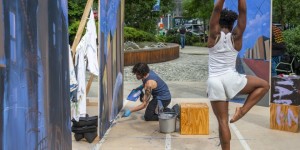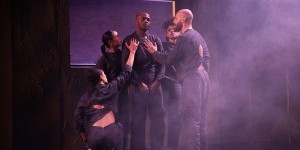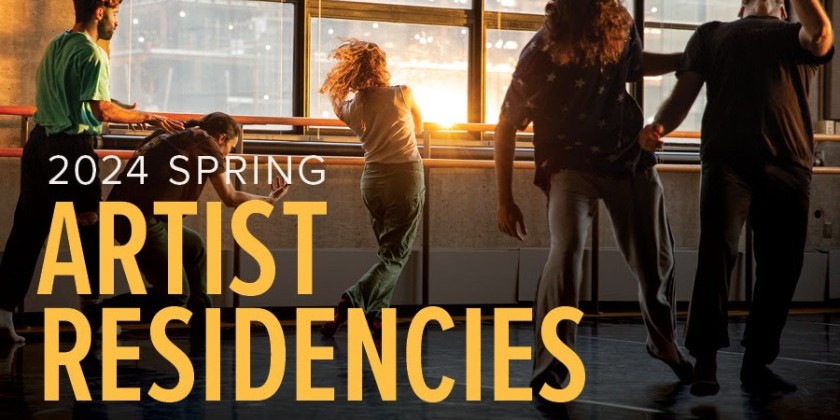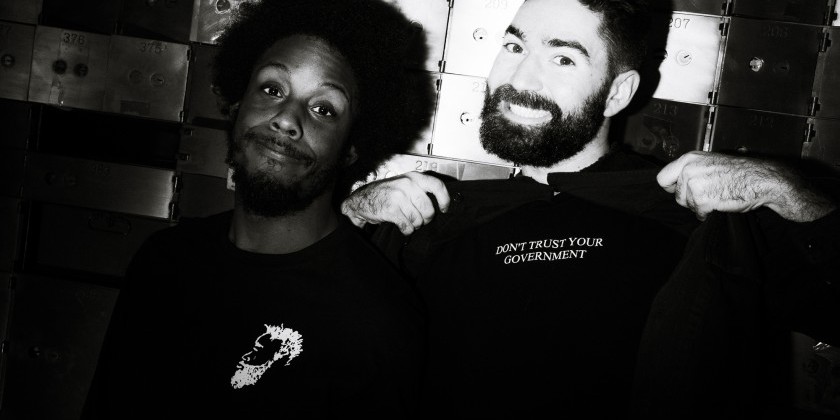IMPRESSIONS: Dance Heginbotham's "Herz Schmerz" at Baryshnikov Arts Center

Director and Choreographer: John Heginbotham
Designer: Maira Kalman
Based on texts by Robert Walser, translated from German by Susan Bernofsky and Christopher Middleton
Lighting Designer: Nicole Pearce
Heart pain is not like other forms of physical distress. Stomach cramps may be troubling; and a Charley horse disabling. Yet even the dread Torticollis cannot compare with ailments of the heart, which have an emotional pang.
Choreographer John Heginbotham attempts to make light of that stabbing feeling in a new work with the dismissive, rhyming title Herz Schmerz (literally “heart pain”), a collaboration with designer Maira Kalman, which received its premiere on Thursday, at the Baryshnikov Arts Center. Yet no amount of silliness, not even the sight of adult men and women twirling beneath an index finger pointed at the top of their heads, can cure those whose hearts know anguish.

For once, love does not appear to be the culprit. The text of Herz, culled from the writings of the late Swiss author Robert Walser, points in a different direction. Lined up across the front of the stage, at the start of the piece, four cast members make a simultaneous, rushed confession. They acknowledge they are deteriorating, even crumbling, and suffer from tiredness. Yes, they might be a little grumpy. People have accused them of nervousness, but they deny losing control.
One does not need to know that Walser was confined to an asylum, or that his literary creations included a butler, an actress, and a monster, in order to recognize these symptoms. What we have here, Herr Doktor, is a full-blown existential crisis; and in the space of 45 minutes (for the show is masterfully economical) Heginbotham and his collaborators take us from the nursery to the edge of the grave, combining romps of childlike gaiety with mature observations of personal decay. The characters tell us they are both sinking and drying out — a paradoxical combination of verbs that may implicate the sands of time. Pity the poor innocent who awakes one day to find himself in an old and decrepit body.

Heginbotham has designed his choreography for a cast with only one professional dancer in it. Actors are so brave! The group includes Kalman herself, a stout woman of a certain age, swathed in a black raincoat and wearing heeled shoes; a reedy man in a sweater and tennis shoes, David Barlow; a more athletic type, Daniel Pettrow, in a yellow suit and T-shirt; and the dancer, Maile Okamura, ready to take flight in a gray dress with its skirt generously cut. Heginbotham keeps their movements simple, but runs them through a maze of patterns.
Though wracked by tremors, they step back from confrontation and skip away. They play peekaboo, emerging from behind a parapet; and they lie on their backs before this wall, raising their legs and sociably crossing feet with one another. Kalman’s foot has to wind its way up in stages, drawing a chuckle from the audience; and at moments like this one the cuteness factor is overwhelming. Heginbotham may, in fact, have a greater affinity for schmaltz than for schmerz. But this is not The Land of Smiles.

More significantly, the performers in this piece gently squeeze their own flesh as if assessing their physical condition. Keeping their fingers crossed behind their backs, they may be praying that the result of this bodily exam is thumbs-up, and not thumbs-down, although thumbs-down is a definite possibility. At another point they extend one hand, clenching and unclenching it; and that gesture, supported by the other hand, has a queasy feeling to it, as if they were donating blood.
Pettrow reflects the performers’ general discomfort with themselves when he inserts one foot in a black shoe that seems to be climbing the wall under its own power, an action that forces him to tilt back at an awkward angle. Taking hold of Pettrow’s hands, Okamura and Barlow pull him on a wild sleigh-ride through imaginary fields of snow, as Kalman showers them with paper snowflakes. What fun! We can all enjoy the sight, even if these are “les neiges d’antan.”

Meanwhile, off to one side, cellist Caitlin Sullivan and pianist Pedja Muzijevic play music by Hans Huber that similarly combines brio with gravitas. On the other side, Susan Bernofsky sits at a table folding and re-folding a napkin, so anyone bored by the dancing can watch her and learn how to entertain stylishly.
Herz’s mise-en-scène is clever; and even the simplest movements have a playful charm. But Heginbotham is, after all, a choreographer; and he’s not content to leave things there. The piece concludes with a solo for Okamura, in which she stretches lyrically, brushes the air, and suddenly scampers. Thanks to this lovely dancer’s artistry, we are able to join her in another realm where all is calm, not tremulous, and where we can experience a feeling of unbroken unity submerged in the flow of movement. Of course, it doesn’t last. But at the end of Herz Schmerz, nervous babbling departs; and transcendence seems attainable, after all.












